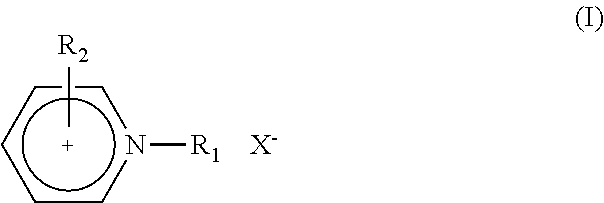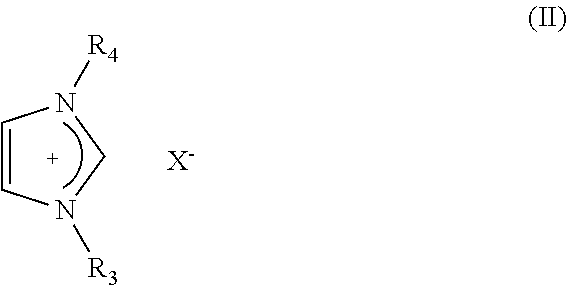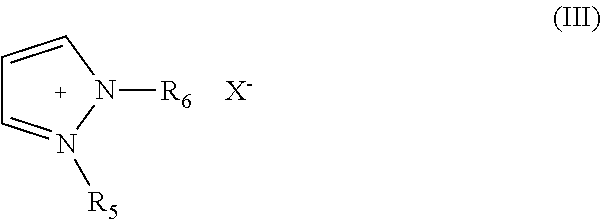Electric Al or Al Alloy Plating Bath Using Room Temperature Molten Salt Bath and Plating Method Using the Same
- Summary
- Abstract
- Description
- Claims
- Application Information
AI Technical Summary
Benefits of technology
Problems solved by technology
Method used
Image
Examples
examples
[0052]The present invention will be described in detail below with reference to the following non-limiting Examples and Comparative examples.
examples 1 to 10
[0053]1,2,3-Trimethylbenzene, 1,2,4-trimethylbenzene and 1,2,3,4-tetrahydronaphthalene as high boiling point aromatic hydrocarbon solvents were blended, in the mixing ratio specified in the following Table 1, with a bath prepared by melt blending AlCl3 (481 g / l) and 1-methyl-3-propylimidazolium bromide (64.7 g / l) (at a molar ratio of 2:1) and then zirconium chloride was added to the resulting blend in each corresponding ratio as specified in the following Table 1 to thus give an electric Al—Zr alloy plating bath. Then an iron plate (thickness: 0.5 mm) used as a cathode was subjected to pretreatments. More specifically, the iron plate was degreased with an alkali, washed through the alkali-electrolysis, then washed with an acid, washed with water and then with ethyl alcohol and finally dried. Using the foregoing iron plate as a cathode and an aluminum plate (purity: 99.9%) as an anode, these electrodes were immersed in the foregoing electric Al—Zr alloy plating bath maintained at 50°...
examples 11 to 16
[0054]Twenty percent by volume of 1,2,4-trimethylbenzene, as a high boiling point aromatic hydrocarbon solvent, and 5 g / L of zirconium chloride were blended with a plating bath prepared by melt blending AlCl3 (481 g / L) and 1-methyl-3-propylimidazolium bromide (64.7 g / L) (at a molar ratio of 2:1). Furthermore an organic polymer (D) and a brightening agent (E) were added to the resulting blend in each corresponding concentration as specified in the following Table 3 to thus give an electric Al—Zr alloy plating bath. Then an iron plate (thickness: 0.5 mm) used as a cathode was subjected to pretreatments. More specifically, the iron plate was degreased with an alkali, washed through the alkali-electrolysis, then washed with an acid, washed with water and then with ethyl alcohol and finally dried. Using the foregoing iron plate as a cathode and an aluminum plate (purity: 99.9%) as an anode, these electrodes were immersed in the foregoing electric Al—Zr alloy plating bath maintained at 50...
PUM
| Property | Measurement | Unit |
|---|---|---|
| Temperature | aaaaa | aaaaa |
| Flash point | aaaaa | aaaaa |
| Concentration | aaaaa | aaaaa |
Abstract
Description
Claims
Application Information
 Login to View More
Login to View More - Generate Ideas
- Intellectual Property
- Life Sciences
- Materials
- Tech Scout
- Unparalleled Data Quality
- Higher Quality Content
- 60% Fewer Hallucinations
Browse by: Latest US Patents, China's latest patents, Technical Efficacy Thesaurus, Application Domain, Technology Topic, Popular Technical Reports.
© 2025 PatSnap. All rights reserved.Legal|Privacy policy|Modern Slavery Act Transparency Statement|Sitemap|About US| Contact US: help@patsnap.com



